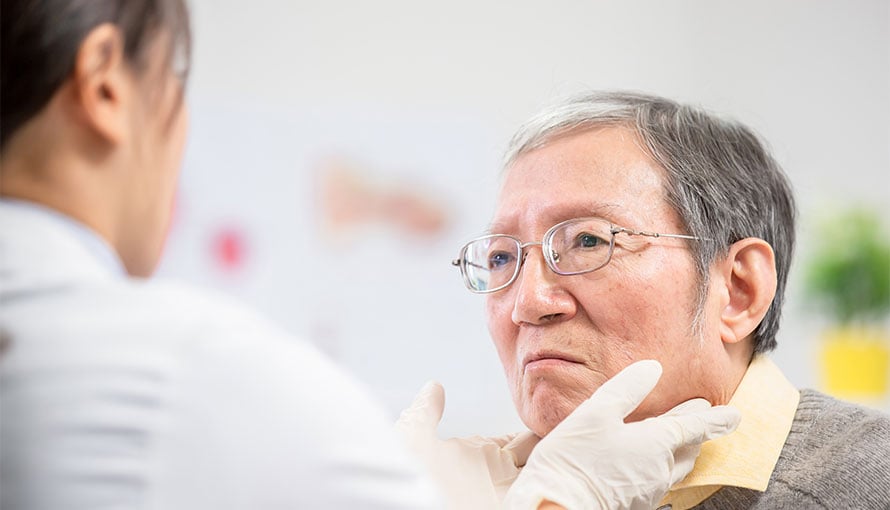Throat and Laryngeal Cancers

Most throat cancers develop either in the flat squamous cells that line the throat (pharynx) or in the voice box (larynx). A funnel-shaped muscular passageway that connects the nose and mouth to the esophagus, the pharynx plays a role in both breathing and digestion. The larynx is a hollow cartilage structure that houses the vocal cords, which vibrate as air passes through them to create the voice.
Types of throat cancer
A type of head and neck cancer, throat cancer is categorized based on its site of origin. Throat cancers that develop in the pharynx are known as pharyngeal cancer, while throat cancers that develop in the larynx are known as laryngeal cancer.
Throat cancer can be further categorized as:
- Nasopharyngeal cancer – Originates in the space behind the nose (nasopharynx)
- Oropharyngeal cancer – Originates in the space behind the mouth (oropharynx)
- Hypopharyngeal cancer – Originates above the esophagus in the lower part of the throat (hypopharynx)
- Glottic cancer - Originates in the vocal cords
- Supraglottic cancer - Originates above the vocal cords in the upper part of the voice box
- Subglottic cancer – Originates below the vocal cords in the lower part of the voice box
Stages of throat cancer
After throat cancer is diagnosed, the next step is determining its extent (stage). Each subtype has unique staging criteria. In general, however, Stage 1 indicates a small tumor confined to one part of the throat, while later stages indicate more extensive cancer.
Causes of throat cancer
Throat cancers develop when healthy cells undergo abnormal changes that cause them to grow and divide uncontrollably. The excess cells then build up, bind together and form tumors.
Scientists are still working to gain a better understanding of what triggers the genetic mutations that lead to throat cancers. Although the specific causes remain unclear, researchers have identified certain factors that increase the risk of throat cancers, including:
- Tobacco use
- Excessive alcohol consumption
- Certain viral infections, such as human papillomavirus (HPV) and Epstein-Barr virus (EBV) (in particular, HPV and throat cancer are strongly linked)
- Gastroesophageal reflux disease (GERD)
Symptoms of throat cancer
Some common signs of throat cancer include:
- Hoarseness and other vocal changes
- Difficulty swallowing
- Sore throat
- Persistent coughing
- Ear or jaw pain
- A palpable lump in the neck
- Unexplained weight loss

Throat cancer diagnosis
To diagnose throat cancer, a physician may:
- Perform an endoscopy – A long, flexible tube with a light and miniature camera attached to the end (endoscope) is guided down the throat. The endoscope captures detailed images of the interior of the throat, which the physician can view on a nearby screen.
- Perform a laryngoscopy – A long, flexible tube with a light and magnifying lens attached to the end is passed down the throat, allowing the physician to examine the vocal cords.
- Perform a biopsy – During an endoscopy or laryngoscopy, a small sample of abnormal tissue is collected for evaluation under a microscope.
- Order imaging tests – CT, MRI or PET scans can be used to evaluate the extent of cancer spread beyond the throat or voice box.
Treatment options and outcomes for throat cancer
To treat throat cancer, an oncologist may suggest:
- Radiation therapy
- Surgery
- Chemotherapy
- Immunotherapy
When detected early, some throat cancers can be cured, especially if the cancer has not spread to surrounding tissues or lymph nodes in the neck. In this situation, the goal of treatment is to completely remove the cancer and prevent it from spreading to other parts of the body.
If the cancer has spread beyond the head and neck, treatment is aimed at enhancing the patient’s quality of life.
Throat cancer prevention–what’s putting you at risk
Although there is no proven way to prevent throat cancer, there are ways to reduce the risk. These include:
- Not using tobacco in any form
- Drinking alcoholic beverages in moderation, if at all
- Consuming a healthy diet rich in vitamin-laden fruits and vegetables
- Taking proactive steps to prevent HPV infection
Throat cancer care at Moffitt Cancer Center
The multispecialty team in the Head and Neck Cancer Program at Moffitt Cancer Center includes experts who specifically focus on throat cancers and lymph node cancers. Our comprehensive services include the latest treatment and supportive care options as well as a robust clinical trials program through which our patients can be among the first to benefit from groundbreaking therapies that are not yet available in other settings.
If you would like to learn more about throat cancers, you can request an appointment with a specialist in the Head and Neck Cancer Program at Moffitt Cancer Center by calling 1-888-663-348 or completing a new patient registration form online. We provide every new patient with rapid access to a cancer expert as soon as possible.
References
Support the Future of Head and Neck Oncology Research and Treatment
When you support Moffitt Cancer Center, you help make breakthrough head and neck research and innovative treatments possible. Give now to support the Head and Neck Oncology Program. For more information, call toll-free 1-800-456-3434, ext. 1403.
Throat Cancer
